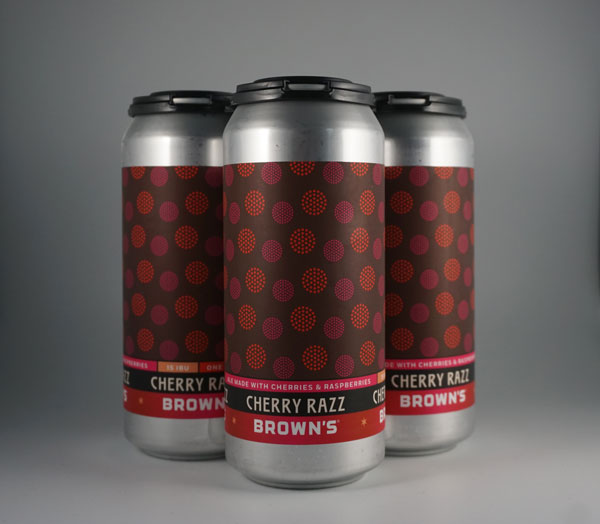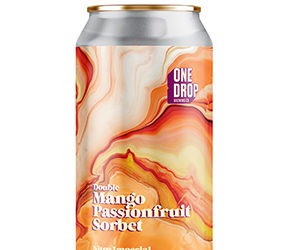Brown’s Brewing Co.’s Cherry Razz clone
(5 gallons/19 L, all-grain)
OG = 1.064 FG = 1.014
IBU = 15 SRM = 12 ABV = 6.6%
Ingredients
9 lbs. (4.08 kg) Pilsner malt
1.75 lbs. (0.79 kg) wheat malt
1.5 lbs. (0.68 kg) crystal malt (20 °L)
12 oz. (0.34 kg) crystal malt (60 °L)
4 oz. (113 g) crystal malt (80 °L)
1 lb. (0.45 kg) frozen raspberries
0.6 lb. (0.27 kg) frozen tart cherries
4 AAU Summit™ hops (60 min.)
(0.25 oz./7 g at 16% alpha acids)
Wyeast 1318 (London Ale III), or White Labs WLP066 (London Fog), or LalBrew Verdant IPA
¾ cup corn sugar (if priming)
Step by Step
Mill the grains, then mix with 4.2 gallons (15.7 L) of 169 °F (76 °C) strike water to achieve a single infusion rest temperature of 154 °F (68 °C). Hold at this temperature for 60 minutes. Vorlauf until your runnings are clear before directing them to your boil kettle. Batch or fly sparge the mash to obtain 6.5 gallons (24.6 L) of wort.
Boil for 60 minutes, adding the Summit™ hops at the beginning of the boil. At 10 minutes left in boil, add a kettle fining agent such as Irish moss or a Whirlfloc tablet and a yeast nutrient of your choice.
After the boil, rapidly chill the wort to slightly below fermentation temperature, which is 66 °F (19 °C) for this beer. Aerate the wort (if using a liquid strain) then pitch the yeast.
Maintain a steady temperature for the duration of active fermentation. Once primary fermentation is done, rack into a secondary fermenter containing the raspberries and cherries. If you have access to carbonation, try to purge the receiving vessel. Allow for complete fermentation of the fruit, which can take up to two weeks.
Bottle or keg the beer and carbonate to approximately 2.5 volumes.
Brown’s Brewing Co.’s Cherry Razz clone
(5 gallons/19 L, extract with grains)
OG = 1.064 FG = 1.014
IBU = 15 SRM = 12 ABV = 6.6%
Ingredients
5 lbs. (2.27 kg) Pilsen dried malt extract
1 lb. (0.45 kg) wheat dried malt extract
1.25 lbs. (0.68 kg) crystal malt (20 °L)
12 oz. (0.34 kg) crystal malt (60 °L)
4 oz. (113 g) crystal malt (80 °L)
1 lb. (0.45 kg) frozen raspberries
0.6 lb. (0.27 kg) frozen tart cherries
4 AAU Summit™ hops (60 min.) (0.25 oz./7 g at 16% alpha acids)
Wyeast 1318 (London Ale III), or White Labs WLP066 (London Fog), or LalBrew Verdant IPA
¾ cup corn sugar (if priming)
Step by Step
Bring 6.5 gallons (25 L) of water to roughly 150 °F (66 °C). Steep the crystal malts for 15–30 minutes before removing. Add both malt extracts, with stirring, until fully dissolved. Turn on heat and bring wort to a boil. Boil for 60 minutes, adding the Summit™ hops at the beginning of the boil. At 10 minutes left in boil, add a kettle fining agent such as Irish moss or a Whirlfloc tablet and a yeast nutrient.
After the boil, rapidly chill the wort to slightly below fermentation temperature, which is 66 °F (19 °C) for this beer. Aerate the wort (if using a liquid strain) then pitch the yeast.
Maintain fermentation temperature. Once primary fermentation is done, rack into a secondary fermenter containing the raspberries and cherries. Allow for complete fermentation of the fruit, which can take up to two weeks.
Bottle or keg the beer and carbonate to approximately 2.5 volumes.
Tips for Success:
This month’s tips all come straight from the brewer, Duncan MacCrea’s pen. First off, “We do a single infusion mash at 154 °F (68 °C), which may seem high for the target final gravity but we do not raise the temperature at the end of the mash to denature the enzymes, we simply allow conversion to continue through lautering and found the higher temperature necessary to not overshoot target final gravity. If you intend to raise the temperature at the end of mashing to denature the enzymes, you will likely find you need a lower target mash temperature to achieve the desired final gravity.”
Secondly, “We once used raspberries and tart cherries in equal proportion but found that reducing the cherries kept the cough syrup flavor from coming through. Be sure to use tart cherries, not sweet cherries. Any amount of sweet cherries tastes like cough syrup after the sugar has fermented out. The fruit is added after the beer has been racked off the yeast into a conditioning tank. This allows time for the sugars of the fruit to ferment without the delicate aromas to be driven off by the vigor of primary fermentation. We centrifuge this beer for clarity but if a centrifuge is not found in your homebrewery, pectic enzyme can aid with clarification.”
Finally, “Any fruit beer, short of some Belgian sour styles, are not intended to be aged and should be consumed fresh. This is no exception. We generally brew, ferment, condition, centrifuge, package, and send this beer out the door within three weeks. Ideally, it spends as little time as possible on the shelf and is consumed fresh.”
Written by Michael Bury




